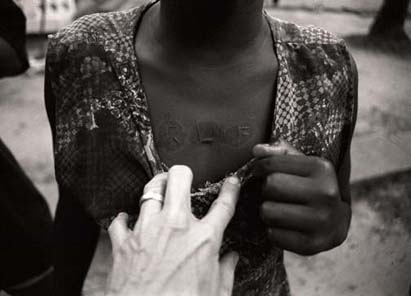CANDACE SCHARSU PHOTOGRAPHY
CANDACE
SCHARSU
in
Afterimage
Magazine
CAPTURING
THE PAIN OF OTHERS
by Jung
Joon Lee
FLASH
POINTS: A FOCUS ON GLOBAL TRAUMA: PHOTOGRAPHS BY GILLES PERESS AND CANDACE
SCHARSU
Sidney
Mishkin Gallery, Baruch College
City University of New York, NYC
November 15 - December 12, 2006
Originally appeared in Afterimage
Vol.34, #5

December 2006 saw Hollywood promoting, with much fanfare, the release of its latest heroic epic, Blood Diamond, in which Leonardo DiCaprio stars as the lovable mercenary chasing wealth in the midst of Sierra Leone's atrocious civil war. Meanwhile, a much more sobering look at this and other tragedies in Africa and around the world could be witnessed at the photography exhibition, "Flash Points: A Focus on Global Trauma: Photographs by Gilles Peress and Candace Scharsu," at Baruch College of the City University of New York. The exhibition presented two contrasting visual accounts of human suffering. On the one hand, it featured some of the most famous photographs by Peress, a former president of Magnum Photos and winner of numerous awards and fellowships, and, on the other, it showed the recent works of Scharsu, a freelance photographer who travels independently to some of the most dangerous conflict zones in Africa. The division of the gallery space, with Scharsu's photographs on one side and Peress's photographs on the other, signaled not only a shift in the geographic location of their subjects but also the visual dichotomy created by the photographers' distinctive approaches to capturing their subjects.
Entering the gallery, the first image I encountered was Scharsu's photograph of a female child whose exposed chest revealed a scar made to read, "R U F." The child, whose face is cropped out of the frame, probably to protect her identity, is a female child soldier branded by Revolutionary United Front (RUF) rebels in Sierra Leone. Scharsu, who spent several months with these war victims in Africa, explains in her descriptive wall label that female soldiers also serve as sex slaves to RUF commanders. Their chests are often branded "R U F " to keep them from returning to their homes, since an association with the RUF could cost them their lives at the hands of their own family. In a color photograph, another young war victim named Ibrahim stares sideways at Scharsu's camera, resting his head on his mutilated hands. At age four, Ibrahim was attacked by RUF rebels in his hometown of Kono, in a diamond mining area. His hands were tied and set on fire by the rebels while his mother was raped and killed. Scharsu's other photographs are equally confrontational. They avoid dramatic angles or narratives, filling the frame with the physical presence of the victims and their suffering, challenging the audience to scrutinize the subjects' wounds.
Displayed on the other side of the gallery was an array of photographs taken from different parts of the world. From Rwanda to Bosnia and Tehran to Belfast. Peress's signature Magnum photographs show dramatic moments of disaster. Four photographs depict the conflicts in Northern Ireland during the 1970s and early 1980s. In Peress's photograph Bottom of William Street One Minute before the British First Parachute Regiment Opened Fire Killing Thirteen Civilians---an Event Known as Bloddy Sunday. Derry Ireland, 1972, one sees the very moment before tragedy strikes. Frozen in time, we see the panic of the crowd, the heavily armored soldiers among them, and the devasted children. The consistency of style and technique in Peress's thirteen photographs is almost formulaic in nature. The wide-angle photographs frequently include a group of people or metonym of their presence, a narrative, children, and carefully composed angles. They undoubtedly reflect Peress's dedication and the almost intuitive skills he deploys amid life-and-death situations. The heightened tension he is able to capture in these dramatic moments conjures up terror, one of the effects of the sublime. The sublime gives beauty to the moment of atrocity and makes the horror digestible for the viewer.
Sierra Leone, West Africa © 2000 by Candace Scharsu, courtesy of the artist.
In the exhibitiion's press release, Peress says, "I'm gathering evidence for history, so that we remember." The carefully composed narratives in Peress's photographs do indeed echo his statement by taking on a didactic nature. In presenting us with images of collective suffering, his photographs give us a lesson on humanity's past mistakes. It is precisely this didactic approach, however, that distracts us from grasping the true agony of the subjects and shields us from confronting the human capacity for horror.
As if to balance Peress's dramatic tone, Scharsu's photographs take on a more intimate approach in communicating suffering. What they convey is raw, straightforward, and up-close. In her portraits of individuals, she eschews the self-consciousness of her presence by filling the frame with the presence of the sitter. They cause us discomfort as we are faced with the painful scars and mutilated limbs of a child or a leper's face. Scharsu's technique forgoes the heroism and mythos invested in the tradition of photojournalism present in Peress's photographs. Except for her hand pulling down the child soldier's shirt, Scharsu's presence remains only in the form of her close relationships with these victiims. "Flash Points: a Focus on Global Trauma" entails not only the global atrocities and trauma but also the ways in which different photographic flash points can tell us different stories about the history and pain of these places and their people.
Concerned Photo Essays: Bushmeat 2014 Sudan: Mundari Wrestlers 2012 Independence South Sudan 2011 Lord Kony in Eastern Congo 2008
Lord Kony in Northern Uganda Blood Diamond War Burma, Daw Aung San Suu Kyi
Cholera Epidemic in Guinea 2007 Haiti Karamojong Warriors Leprosy in Zambia Malaria Midwives in Africa 2008
Pygmies of Central Africa Republic of Congo Tibet, Vietnam, India The Tuaregs of Niger
Africa's Beauty: Black & White Color About: Exhibits Self Portrait Press Contact
Contact / Purchase Inquiries: cscharsu [at] gmail [dot] com